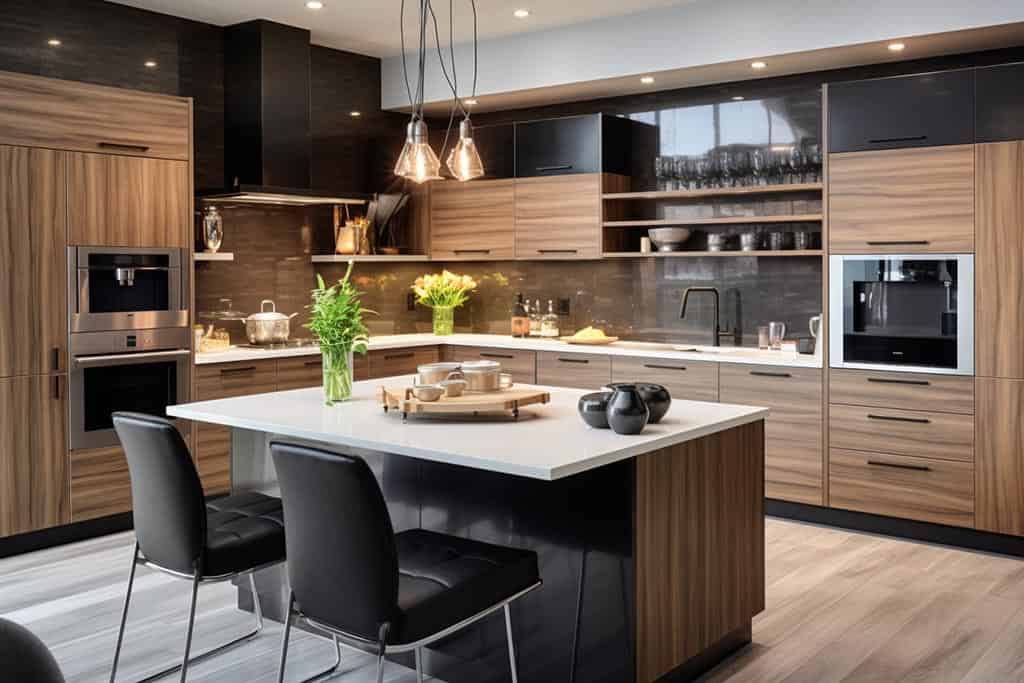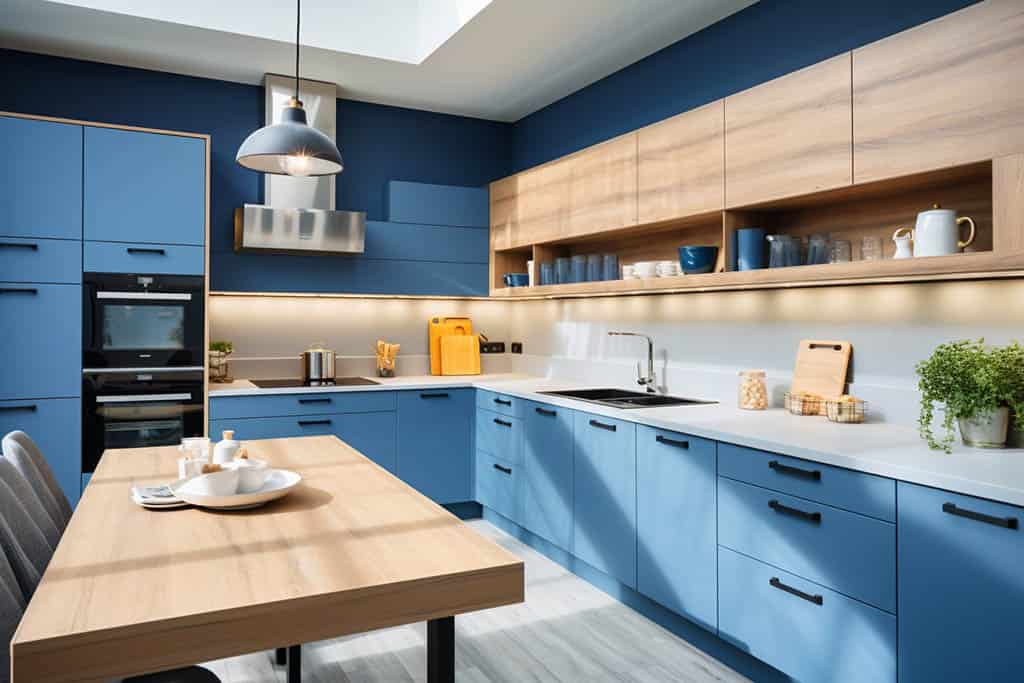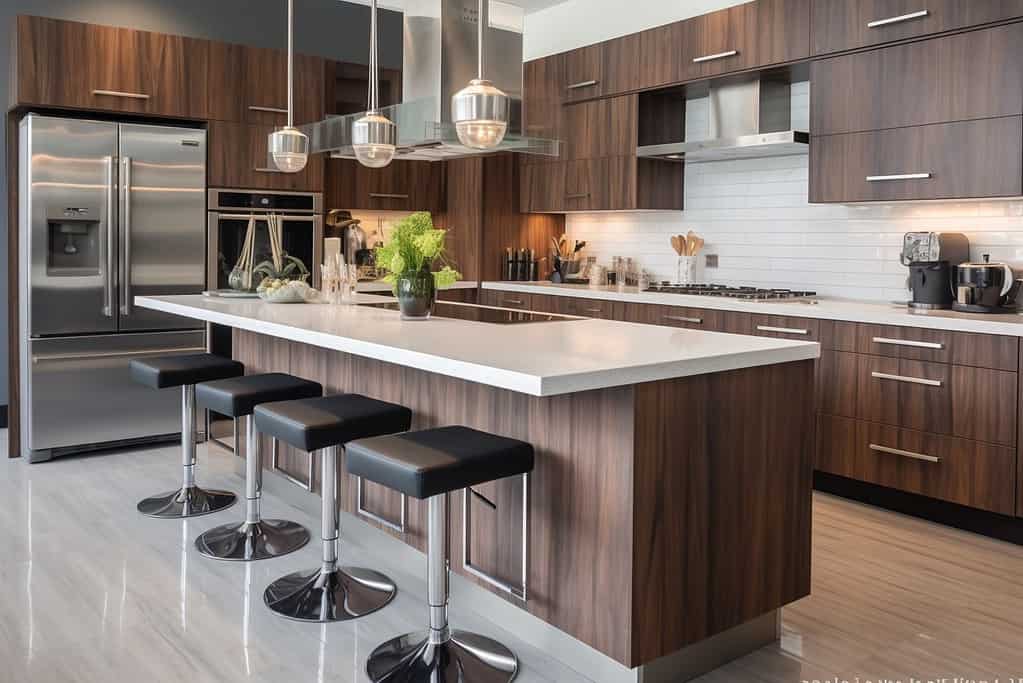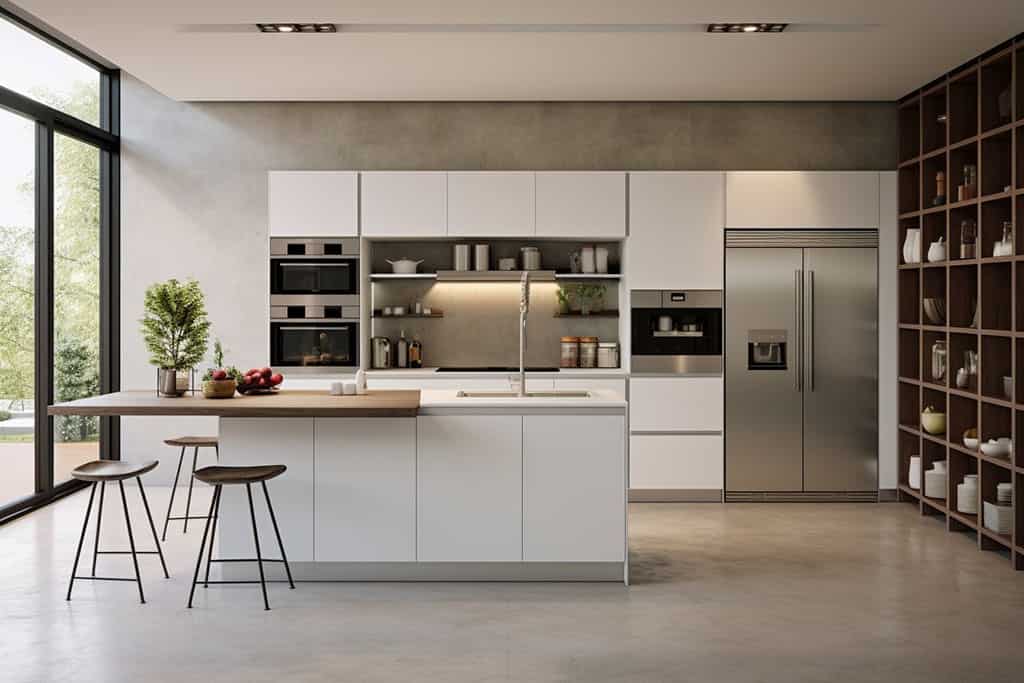
Cabinets make up the majority of the kitchen size. They are also the main feature of the kitchen, that you would like to always be in their best shape. And if they are structurally sound you may update them by kitchen cabinet repainting or restaining. These kitchen cabinet refinishing options are an affordable and quick way to give life back to drab cabinets. It means you keep the current cabinetry, but change its color or finish. This is usually done by sanding the cabinet surface or chemically stripping it of the old finish with subsequence applying the new coat of paint or stain.
Whether you’re looking to update the style, enhance durability, or simply refresh the overall aesthetic, exploring the available options for refinishing allows you to tailor your cabinets to your unique taste and preferences. Let’s delve into the diverse range of refinishing kitchen cabinet ideas available, from traditional techniques like staining and painting to innovative methods such as kitchen cabinet spraying.
What types of cabinets can be refinished?
When contemplating a cabinet refinishing project, you’re not limited by the type of material your cabinets are made from. Whether you have wooden, MDF (Medium-Density Fiberboard), particleboard, or even metal kitchen cabinets, the process can breathe new life into any surface. Let’s explore the versatility of refinishing across different cabinet materials:
Repainting wooden kitchen cabinets
Wooden cabinets are a classic with oak as the most common choice in kitchens. Oak kitchen cabinet refinishing usually allows you to move away from the outdated honey tone and get gorgeous structurally sound cabinets with unique grain that can be tinted from light grey to espresso dark hues without quality loss. And the opposite, repainting oak kitchen cabinets with arch doors in white can completely change that dated feel to modern. Closed-grain hardwoods make the process even easier giving refinishing maple kitchen cabinets that open up a vast array of colour and hue options.
Repainting MDF kitchen cabinets
The medium-density fiberboards are made of engineered material. The material has no wood grain and staining them is not an option if we talk about exposed MDF cabinets. For the same reason, MDF’s smooth and uniform surface is perfect for painting. To avoid moisture damage, fiberboards must be treated and sealed properly before being painted. MDF cabinets covered by veneer, however, are excellent candidates for new finish coats, both paint or stain. The kitchen cabinet doors that are refinished can be made out of MDF, which you may never notice.
Refinishing laminate kitchen cabinets
Refinishing cheap laminate-covered particleboard cabinets is a budget-friendly way to upgrade your kitchen. While laminate can not be sanded without avoiding its structure the preparation includes thorough cleaning and priming. Choose a high-quality paint that adheres well to laminate for a durable and attractive result. If you notice the signs of warping, consider resurfacing laminate cabinets. This option is more intense in hassle and costs but still more affordable than replacing whole cabinets.
Refinishing metal kitchen cabinets
Yes, even metal kitchen cabinets can undergo a stunning transformation through refinishing. Start by cleaning and preparing the metal surface, and then select a paint specifically designed for metal applications. The right paint ensures adhesion and durability, allowing you to achieve a fresh, modern look for your metal cabinets.
Repainting kitchen cabinets

But paint is not just about its appearance, it has other qualities and uses beyond aesthetics. It protects your cabinets against damage from heat and moisture. Any other type of kitchen renovation would be far more expensive than kitchen repainting cabinets. Instead, you can spend the remaining funds on other upgrades, like crown mouldings or a new appliance.
There are also a few drawbacks of kitchen cabinet repainting:
-
It’s not a good idea to paint cabinets that have damage. Repainting old damaged kitchen cabinets will either make the spoilage stand out more or cause the paint to crack easily. Consider kitchen cabinet repair and subsequent refinishing.
-
A smooth and even painted surface will highlight any dirt in the kitchen. The paint will also be harder to touch up if there are any kind of flaws.
-
Finishing updating cabinets does not upgrade your kitchen functionality, nor add storage. If you have issues, such as malfunctioning drawer rails or difficulties reaching dead corner cabinets, they still be there when the cabinets become shining as new.
-
Despite the common thought, it is not easy to paint on your own. Kitchen cupboard repainting is a complicated and lengthy process that requires thoughtful planning and preparation.
Do-it-yourself kitchen cabinet repainting
Undertaking a kitchen cabinet repainting project might seem like a straightforward task, but in reality, it demands careful planning, attention to detail, and a methodical approach. Before attempting any kitchen cabinet repainting ideas, it is crucial to understand the task at hand.
-
Choosing the paint
Opt for a high-quality paint specifically designed for cabinets. This ensures durability and a smooth finish. Consider whether a latex or oil-based paint is more suitable for your cabinets, taking into account factors like ease of application and drying time.
-
Preparation
Begin by removing cabinet doors, drawers, and hardware. For kitchen cabinet doors refinishing label each piece to streamline the reassembly process. Clean surfaces meticulously, removing grease, grime, and any residue that might hinder paint adhesion.
-
Sanding and priming
For refinishing painted kitchen cabinets you may use paint remover, to completely clear the paint and reach the naked surface. If you’d explore natural wood or undamaged veneer you may consider kitchen cupboard door refinishing with stain instead. It’s advisable to sand lightly to create a suitable surface for any finish adhesion. Repainting painted kitchen cabinets apply a quality primer to enhance the new finish’s durability and provide a solid foundation for an even result.
-
Painting
Invest in quality brushes for a professional finish. Consider using a foam roller for smooth surfaces. Apply two thin coats instead of one thick coat to prevent drips and achieve an even finish.
-
Drying time and reassembly
Allow ample drying time between coats as per the paint manufacturer’s recommendations. Reassemble cabinets only after ensuring that each painted component is thoroughly dry and cured.
-
Cabinet hardware upgrade
Take advantage of the opportunity to upgrade cabinet hardware for a complete and cohesive look. Ensure proper alignment and placement of hardware for a polished appearance.
-
Sealing and protection
Apply a clear polyurethane topcoat or a protective sealer to safeguard the painted surface against daily wear and tear. Exercise patience, allowing the cabinets to cure fully before resuming regular kitchen activities.
By approaching the DIY kitchen cabinet refinishing process with patience and a systematic mindset, you can achieve a professional-looking outcome.
Repainting kitchen cabinet tricks
As we already know, DIY repainting kitchen cabinets involves more than just selecting a new colour. It’s a process that demands attention to detail and a grasp of various tricks to ensure a flawless outcome.
Hole caulking
When repainting kitchen cupboard doors you have to remove all the hardware. If you plan to attach it back, you better label which handle belongs to which door, the same way you did when removing doors from hinges. Most homeowners want to replace the hardware with a new one, though, to achieve a brand-new look of cabinets. Then, for smooth kitchen cabinet door repainting, it is important to caulk all the holes from the old fittings. This is usually done using a wood putty or filler. Thus, you may drill holes to apply new modern hardware after repainting kitchen cabinet doors. Make sure to place cabinet knobs in the opposite direction of hinges, 5-8 cm away from the bottom corner of wall cabinets and 5-8 cm from the corner of base cabinet doors.
Sanding
While repainting kitchen cabinets without sanding is possible, you should take into account that such a painting outcome will not last long. Sanding is essential since it removes any protective sealant or sheen from cabinet drawers and doors and allows primer and paint to stick well to the surface. If the doors and drawer fronts have been treated with wood putty or filler, it helps to smooth any scratches, dents and lumps that would stay visible if refinishing kitchen cabinets without sanding. For most cabinets and drawer faces, low-grit or fine-grit sanding paper works well. However, rough grit is best for cabinets covered in glazing and lacquer.
Priming
Repainting kitchen cabinets in white or other light-coloured hues requires using a quality stain-blocking primer. By using ones, you can create an effective surface to bond paint and reduce the amount of coats. For light-coloured paints, you will need to apply only one coat of each primer and paint. Those who strive to refinish white kitchen cabinets to apply dark or bold colours of paint will benefit from a tinted base. Add a base tone that matches the paint to make a tinted paint primer. This will ensure good coverage.
Spray painting
When it comes to refinishing kitchen cupboards, especially those crafted from laminate, the traditional methods of sanding and stripping are not applicable due to the unique characteristics of the material. A practical alternative for laminate is the kitchen cabinet spraying and refinishing. This technique involves using a high-quality spray paint designed for delicate finishes. You may rub the surface with a spirit and sponge, removing any grease, dirt, or residue that may hinder the paint from adhering effectively. The application of spray paint is challenging, and it’s crucial to follow proper techniques. Using even, controlled strokes and maintaining an appropriate distance from the surface helps achieve a consistent coat without drips or uneven coverage. When repainting kitchen cupboards with spraying it is necessary to create a special nook from plastic sheets so as not to get paint all around. Good ventilation is required, so consider doing a job outside on a sunny day.
Restaining kitchen cupboards

Restaining is a meticulous process that involves revitalizing the appearance of your wood or veneer kitchen cabinet by stripping and refinishing it with a new, fresh stain. Kitchen cabinet restaining allows you to customize the look of your cabinets and breathe new life into your kitchen space.
You may choose the stain of different hues. The selection of a stain colour is a pivotal decision that can significantly impact the overall ambience of your kitchen. Homeowners can opt for restaining kitchen cabinets lighter to create an airy and open feel. The warmer and colder hues are also a choice. For instance, when restaining oak kitchen cabinets, you may go for white-washed, grey, light brown or red wood stains, it is up to your desired aesthetic.
You may also prefer restaining kitchen cabinets darker for a more dramatic and sophisticated appearance. The choice of stain colour is not only a matter of personal preference but also involves considering the existing colour scheme of the kitchen and the desired mood. Pay attention that it is more complicated and requires advanced skills to re-stain dark cabinets to lighter hues, so make your choice wisely.
To commence the cabinet restaining process, it is imperative to perform a few steps:
-
Prepare all the necessary tools, like screwdrivers, sanding paper, block or pad, painting tape, brushes, stains, stripping agent and soft cloth. Prepare the room for a dusty job by covering the furniture and surfaces with plastic film.
-
Empty and wipe clean all the cabinets involved. Unscrew the handles and remove inner shelves; unmount all the doors, label all the doors in advance, and unfasten the hinges.
-
Strip away the existing finish on the cabinets and doors. This can be achieved through the use of appropriate stripping agents or sanding techniques, depending on the type of finish that needs to be removed. It is crucial to ensure that the surface is thoroughly cleaned and prepared before moving on to the staining phase.
-
Once the cabinets have been thoroughly sanded, inspect them for any wood or veneer imperfections, ensuring a seamless surface.
-
Before applying the chosen stain, it is advisable to test a small, inconspicuous area to ensure that the colour matches your expectations. This precautionary step helps in avoiding any unwanted surprises and allows for adjustments if necessary.
-
Once satisfied with the chosen colour, the staining process can begin, with careful attention to detail to ensure an even and consistent application. Adequate drying time between coats is essential to achieve a professional and durable finish.
-
Finally, applying a protective sealant or topcoat after the staining process is completed adds a layer of protection against wear and tear, ensuring the longevity of the newly transformed kitchen cabinets.
Kitchen cupboard restaining is a rewarding undertaking that demands precision, creativity, and a commitment to detail. If you are not aware of the process, it is advisable to call professionals. There are a lot of woodworkers in Australia who would love to perform a job for you. Restaining kitchen cabinets cost, in such a case, will depend on the size of your cabinets, their condition, since refinishing old kitchen cabinets might be complicated, and the desirable hue.
By stripping away the old and embracing the new, homeowners can achieve a refreshed and personalized kitchen space that reflects their unique style and enhances the overall appeal of their home.
Kitchen cabinet refinishing ideas
When it comes to choosing paint, you do not have to limit yourself to any ideas for refinishing kitchen cabinets such as gloss grade or colour options. Paint technology has advanced significantly, offering a wide range of finishes, from matte to high gloss, and textured with an extensive palette of colours. This freedom enables you to express your personal style and create a kitchen that resonates with your taste. Here are a few inspiring DIY-friendly refinishing kitchen cabinet ideas:
-
Two-tone elegance
Create visual interest by adopting a two-tone approach. Choose light and restraint colours for upper cabinets and wooden warmth for stained lower cabinets, or even experiment with a different colour for an island or specific cabinet sections. This technique adds depth and dimension to your kitchen design.
-
Playful colour palettes
Embrace the full spectrum of colours to inject personality and vibrancy into your kitchen. From calming pastels to bold and dramatic hues, your colour choices can reflect your unique style. Consider mixing and matching painted doors with transparent glass ones for an eclectic look that stands out.
-
Elegant matte finishes
Opt for a sophisticated and understated look with matte finishes. Matte surfaces exude a timeless elegance, creating a smooth and velvety appearance. This choice is perfect for those who appreciate a contemporary and subdued aesthetic, allowing other design elements to shine.
-
Chic high gloss statements
Make a bold statement with high gloss finishes that reflect light and add a touch of luxury to your kitchen. High gloss cabinets are not only visually striking but also easy to clean, making them an excellent choice for modern and glamorous kitchen spaces.
Cost of refinishing kitchen cabinets

Kitchen refinishing cabinets will add style and value to your home at a low price. It took, on average, $300 to repaint the cabinets. If you’d hired someone to refinish the cupboards, you could have spent up to a thousand dollars. But still, the cost of refinishing kitchen cabinets is a pivotal consideration for homeowners looking to give their kitchen a facelift.
Factors influencing the cost of repainting kitchen cabinets
The most important factor in terms of kitchen cabinet refinishing cost is the current cabinet condition. Cupboards in good condition may require less preparation. The worse the cabinet shape is, the more it affects both time and material costs and often requires professional treatment. Also, the inclusion of features like new hardware, special finishes, or intricate detailing can contribute to higher overall refinishing kitchen cabinets costs.
The cost of painting kitchen cabinets depends a lot on cabinet size and layout complexity as well. Large cabinets or those with intricate designs may require more time and resources, impacting the overall price rate.
Refinishing kitchen cabinets DIY vs. professional services
Overall, the decision between DIY and professional refinishing hinges on your budget, available time, and desired level of expertise. DIY projects often provide budget savings, but professional services offer convenience and a polished result.
| DIY refinishing | Professional refinishing |
|---|---|
|
Materials – the primary expenses in a DIY project include the cost of paint, primer, brushes, sandpaper, and any additional tools required. Choosing high-quality materials may contribute to a slightly higher upfront cost but often results in a more durable finish. |
Materials and tools – professionals often have access to high-quality materials and tools, which can contribute to a more refined and long-lasting finish. The cost of these materials is typically a bit more expensive unless a contractor has a special discount. |
|
Equipment – if you don’t already own them, purchasing or renting sanders, sprayers, or other specialized equipment can impact the overall cost. |
Labour costs – hiring professionals means you’re paying for their expertise and time. The cost to paint kitchen cabinets professionally in Australia can vary based on the scope of the project, the intricacy of the refinishing work, and your geographical location. |
|
Time investment – while not a direct monetary cost, the time you spend on a DIY project should be considered. DIYers often find the process rewarding, but it will definitely take your time and effort |
Long last investment – opting for professional services means you pay a good price for services. Since you are hiring an expert you’ll be sure the job is done at the highest level and with a guarantee applied. Additionally, it means you won’t need to worry about purchasing or renting equipment, spending time on meticulous prep work, or troubleshooting any unexpected challenges that may arise during the refinishing process. |
Whichever path you choose, understanding the associated repainting kitchen cabinets costs empowers you to make an informed decision that aligns with your vision for a refreshed kitchen space.
FAQ
What to choose: kitchen refinishing or refacing?
When refacing, you cover your existing cabinets with a new coat of material, like a laminate, wood veneer or thermofoil. As well as replace cabinet doors and drawer fronts and add new hardware. While kitchen cupboard refinishing involves staining or painting to add them a fresh look. It is also the fastest and cheapest way to update your kitchen and requires the cabinets to be in good condition.
What types of cabinets can be refinished?
When contemplating a cabinet refinishing project, you’re not limited by the type of material your cabinets are made from. Whether you have wooden, MDF (Medium-Density Fiberboard), particleboard, or even metal kitchen cabinets, the process can breathe new life into any surface.
Is it possible to repaint the kitchen cabinets myself?
Undertaking a kitchen cabinet repainting project is indeed possible for DIY enthusiasts. However, it’s crucial to understand that it demands careful planning, attention to detail, and a methodical approach. Patience and a systematic mindset are essential for achieving a professional-looking outcome.
How does restaining kitchen cabinets differ from repainting?
Restaining is a meticulous process involving revitalizing the appearance of wood or veneer cabinets by stripping and refinishing with a new stain. It allows for the customization of cabinet looks, with choices ranging from lighter hues for an airy feel to darker tones for a dramatic appearance.
What can affect the cost of refinishing kitchen cabinets?
The most significant factor is the current condition of the cabinets. Cabinets in good condition may require less preparation, impacting both time and material costs. The cabinet size, layout complexity, and the inclusion of features like new hardware also contribute to the overall cost.
